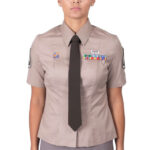The U.S. Coast Guard has updated its uniform policy, offering women new options for hairstyles. This significant change, detailed in the latest Uscg Uniform Manual, now permits women to wear their hair in one or two braids or a single ponytail.
This policy revision is welcomed as a practical and inclusive update. Rear Admiral Joanna Nunan highlighted the relief this brings to women in the service, freeing them from the constraints of traditional buns and complicated hairstyles that often led to discomfort and hair damage. The Coast Guard’s Uniform Board carefully considered similar updates made by other branches of the military when reviewing this policy change, ensuring alignment with evolving standards.
Understanding the New Hairstyle Options in the USCG Uniform Manual
The updated USCG Uniform Manual specifies the parameters for these new hairstyles to maintain a professional and standardized appearance:
- Single Braid or Ponytail: When choosing a single braid or ponytail, it must be centered on the back of the head. Side ponytails or braids are not authorized. The bulk of the hair should also not extend wider than the wearer’s head.
- Two Braids: For those opting for two braids, they must be evenly spaced and symmetrical when viewed from the back, ensuring a neat and uniform look.
- Length Restrictions: Regardless of whether wearing one or two braids or a ponytail, the length of the hair cannot extend below a horizontal line centered between the shoulder blades. This ensures practicality and uniformity across the force.
Exceptions and Safety Considerations Under the USCG Uniform Manual Guidelines
While these new hairstyle options offer greater flexibility, the USCG Uniform Manual emphasizes that safety remains paramount. In specific operational environments, it is still necessary to pull hair back tightly to mitigate risks. These situations include, but are not limited to:
- Operating or working near hazardous machinery or equipment
- Proximity to power transmission equipment, rotary equipment, or moving parts
- Environments involving hazardous chemicals or open flames
Furthermore, the USCG Uniform Manual clearly states that hairstyles must never impede vision. If there is any uncertainty regarding hairstyle appropriateness in specific duties or environments, personnel are advised to consult with their command to ensure both safety and compliance.
Further Updates in the USCG Uniform Manual
Beyond the significant changes to women’s hairstyles, the recent update to the USCG Uniform Manual also includes several other notable revisions:
- Windbreaker Authorization: The windbreaker is now authorized to be worn in place of the Service Dress Blue (SDB) jacket during transit to formal events. However, the SDB jacket must be donned before the formal event itself.
- Dress Shirt Modernization: The current light blue dress shirt will be replaced with a new Air Force Herringbone material shirt. In line with the Air Force design, pockets will be removed from the female dress shirts.
- Air Force Skirt Authorization: The Air Force skirt is now authorized for wear with the Tropical Blue (Trops) uniform. It is not authorized with the SDB uniform due to a slight color variation.
- Coyote Ball Cap Rank Insignia: Personnel authorized to wear the Coyote colored ball cap with the Navy Working Uniform (NWU) Type III are now authorized to wear subdued rank insignia on the cap.
These updates to the USCG Uniform Manual reflect the Coast Guard’s commitment to modernizing its policies while maintaining professionalism and safety standards. Personnel are encouraged to review section 2.B of the Coast Guard Uniform Regulations Manual COMDTINST 1020.6L for the complete and official details on these changes.

